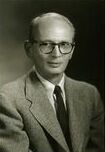Salomon Bochner (20 August 1899 – 2 May 1982) was a Galizien-born mathematician, known for work in mathematical analysis, probability theory and differential geometry.
Life
editHe was born into a Jewish family in Podgórze (near Kraków), then Austria-Hungary, now Poland. Fearful of a Russian invasion in Galicia at the beginning of World War I in 1914, his family moved to Germany, seeking greater security. Bochner was educated at a Berlin gymnasium (secondary school), and then at the University of Berlin. There, he was a student of Erhard Schmidt,[3] writing a dissertation involving what would later be called the Bergman kernel. Shortly after this, he left the academy to help his family during the escalating inflation[broken anchor]. After returning to mathematical research, he lectured at the University of Munich from 1924 to 1933. His academic career in Germany ended after the Nazis came to power in 1933, and he left for a position at Princeton University. He was a visiting scholar at the Institute for Advanced Study in 1945 to 1948.[5] He was appointed as Henry Burchard Fine Professor in 1959, retiring in 1968. Although he was seventy years old when he retired from Princeton, Bochner was appointed as Edgar Odell Lovett Professor of Mathematics at Rice University and went on to hold this chair until his death in 1982. He became Head of Department at Rice in 1969 and held this position until 1976. He died in Houston, Texas. He was an Orthodox Jew.[6]
Mathematical work
editIn 1925 he started work in the area of almost periodic functions, simplifying the approach of Harald Bohr by use of compactness and approximate identity arguments. In 1933 he defined the Bochner integral, as it is now called, for vector-valued functions. Bochner's theorem on Fourier transforms appeared in a 1932 book. His techniques came into their own as Pontryagin duality and then the representation theory of locally compact groups developed in the following years.
Subsequently, he worked on multiple Fourier series, posing the question of the Bochner–Riesz means. This led to results on how the Fourier transform on Euclidean space behaves under rotations.
In differential geometry, Bochner's formula on curvature from 1946 was published. Joint work with Kentaro Yano (1912–1993) led to the 1953 book Curvature and Betti Numbers. It had consequences, for the Kodaira vanishing theory, representation theory, and spin manifolds. Bochner also worked on several complex variables (the Bochner–Martinelli formula and the book Several Complex Variables from 1948 with W. T. Martin).
Selected publications
edit- Bochner, S. (1932). Vorlesungen über Fouriersche Integrale. Leipzig: Akademische Verlagsgesellschaft m.b.H.[7]
- Bochner, S. (1948). Vorlesungen über Fouriersche Integrale. New York: Chelsea Pub. Co.
- Bochner, S. (1959). Lectures on Fourier integrals; with an author's supplement on monotonic functions, Stieltjes integrals, and harmonic analysis. Translated from the original by Morris Tenenbaum and Harry Pollard. Princeton, N.J.: Princeton University Press.
- Bochner, S. (1938). Lectures on commutative algebra. Ann Arbor, Mich.: Planographed by Edwards Brothers, inc; lectures given in 1937-1938, nootes by J. W. Tukey, J. Giese, and V. Martin
{{cite book}}: CS1 maint: postscript (link) - Bochner, S.; Martin, William Ted (1948). Several complex variables. Princeton: Princeton Univ. Press.[8]
- Bochner, S.; Chandrasekharan, K. (1949). Fourier transforms. Princeton: Princeton Univ. Press.[9] 2016 reprint
- Yano, K.; Bochner, S. (1953). Curvature and Betti numbers. Princeton: Princeton University Press. ISBN 0691095833.[10]
- Bochner, S. (1955). Harmonic Analysis and the Theory of Probability. University of California Press. 2013 reprint
- Bochner, S. (1966). Role of mathematics in the rise of science. Princeton, N.J.: Princeton University Press.[11] 2014 reprint
- Bochner, S. (1969). Selected mathematical papers of Salomon Bochner. New York: W. A. Benjamin.
- Bochner, S. (1969). Eclosion and synthesis; perspectives on the history of knowledge. New York: W. A. Benjamin.
- Bochner, S. (1979). Einstein between centuries. Houston, Texas: William Marsh Rice University.
- Bochner, Salomon (1992), Gunning, Robert C. (ed.), Collected papers. Part 1, Providence, R.I.: American Mathematical Society, ISBN 978-0-8218-0174-1, MR 1151390
- Bochner, Salomon (1992), Gunning, Robert C. (ed.), Collected papers. Part 2, Providence, R.I.: American Mathematical Society, ISBN 978-0-8218-0175-8, MR 1151391
- Bochner, Salomon (1992), Gunning, Robert C. (ed.), Collected papers. Part 3, Providence, R.I.: American Mathematical Society, ISBN 978-0-8218-0176-5, MR 1151392
- Bochner, Salomon (1992), Gunning, Robert C. (ed.), Collected papers. Part 4, Providence, R.I.: American Mathematical Society, ISBN 978-0-8218-0177-2, MR 1151393
See also
editReferences
edit- ^ "[the st-and.ac.uk "Biography" entry for] Salomon Bochner".
- ^ "[the st-and.ac.uk "Society Prizes" entry for] The Leroy P Steele Prize of the AMS". Archived from the original on 9 June 2015. Retrieved 8 January 2015.
- ^ a b Salomon Bochner at the Mathematics Genealogy Project
- ^ "Bernard Russell Gelbaum". Mathematics Genealogy Project. Retrieved 28 March 2021.
- ^ Institute for Advanced Study: A Community of Scholars
- ^ "Bochner biography". Archived from the original on 7 November 2019. Retrieved 25 February 2008.
- ^ Franklin, Philip (1933). "Book Review: Vorlesungen über Fouriersche Integrale". Bulletin of the American Mathematical Society. 39 (3): 184–185. doi:10.1090/S0002-9904-1933-05565-9.
- ^ Cooper, J. L. B. (1949). "Reviewed work: Several Complex Variables Salomon Bochner, William Ted Martin". The Mathematical Gazette. 33 (305): 218–220. doi:10.2307/3611424. JSTOR 3611424.
- ^ Segal, I. E. (1950). "Book Review: Fourier transforms". Bulletin of the American Mathematical Society. 56 (6): 526–529. doi:10.1090/S0002-9904-1950-09436-1.
- ^ Boothby, William M. (1954). "Book Review: Curvature and Betti numbers". Bulletin of the American Mathematical Society. 60 (4): 404–406. doi:10.1090/S0002-9904-1954-09834-8.
- ^ Cannon, Walter F. (1967). "Review of The Role of Mathematics in the Rise of Science by Salomon Bochner". Isis. 58: 119–120. doi:10.1086/350200.
